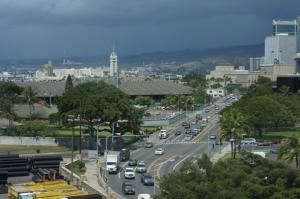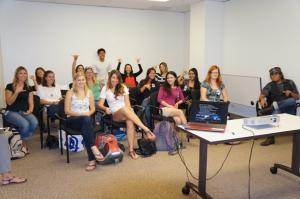Clinical services for the public being restored in wake of UH campus fire
JABSOM Communication Sciences Program relocated
University of Hawaiʻi at MānoaContact:
Posted: Mar 6, 2012
The John A. Burns School of Medicine (JABSOM) plans to resume clinical appointments as early as this week with clients who depend on the school’s Communication Sciences and Disorders (CSD) Department for speech and language therapy. The department’s clinic and its students and faculty were displaced February 12 by a fire that destroyed a building in the lower campus of the University of Hawai’i at Mānoa.
Classes have continued without major disruption for the 24 master’s degree students and seven faculty members of the department, thanks to rapid logistical support from the University System, UH Mānoa and JABSOM. The students and faculty were immediately relocated to JABSOM’s campus at 651 Ilalo Street in Kaka’ako, and currently they are moving into space being leased by the medical school at 677 Ala Moana Boulevard (the former Gold Bond Building).
The school intended to permanently establish the new home for CSD by summer.
“We were planning to move the department this coming May to improve the educational and treatment environment for the students, faculty and members of the public who depend on our audiologists and communication therapists,” said JABSOM Dean Jerris Hedges, MD. “With quick action by our administrative team and our Mānoa and UH System colleagues, we have been able to secure space early for the new offices and clinical treatment area.”
Students in CSD are required to complete 400 hours of clinical therapy, so the loss of a clinical treatment area since February 12 has been a serious concern.
“At first, we didn’t know exactly what was going to happen, whether we were going to be able to move until May,” said first-year CSD Master’s student Janelle Hiu. “Everybody’s been really nervous about whether things could be pushed up. We are very grateful that we have been embraced here and we were able to continue classes and it’s not going to have a long-term effect on our projected graduation and our learning.”
Hiu says everyone’s first concern, however, was getting word to the speech and hearing-impaired clients they see that therapy visits would have to be postponed. Assistant Professor Dr. Christine Fiestas was worried that students might lose momentum with their clients and the clients suffer regression in their progress.
“The clients really do bond with their graduate student clinicians, there’s a lot of communication not only between the clinicians and clients but between the clinicians and the family,” said Fiestas.
According to Hiu, it turned out their clients were most concerned about them.
“They were concerned about our safety and whether any of us were hurt,” she said. “I’m very glad we have been able to get a lot of positive things out of such a bad thing, a fire. Not only for the students, but we are moving to a location where there is actually access to a lot more things for our clients, too, when we are fully up and running,” said Hiu.
The CSD will contact clients to let them know when their individual therapy sessions will resume. Upper-level students who see clients in external settings, including at the Tripler Army Medical Center and for the Easter Seals, have not been affected.
In addition to treating Hawai’i’s citizens who are speech or hearing impaired and offering hearing screening for school children and the public, CSD conducts research into communications disorders. One ongoing study aims to learn whether the deployment of U.S. military members has caused them to suffer significant hearing loss. Another project is seeking to discern whether standard measures to evaluate language-learning difficulties need to be revised to take into account cultural differences among people, including those for whom English is a second language.



